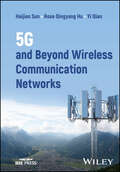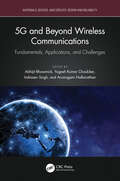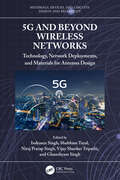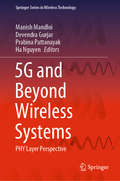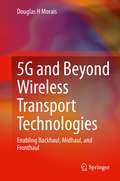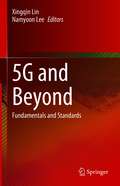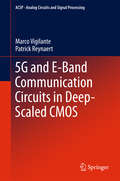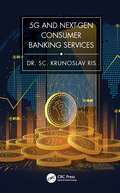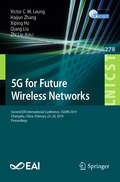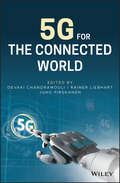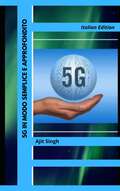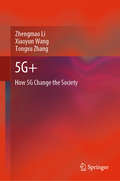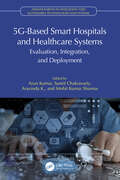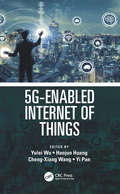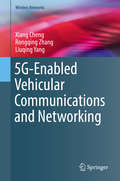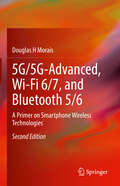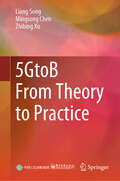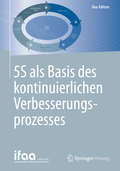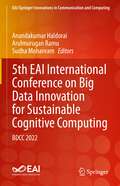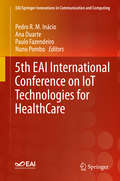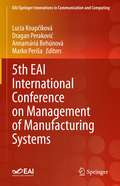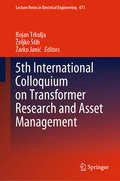- Table View
- List View
5G and Beyond Wireless Communication Networks (IEEE Press)
by Yi Qian Rose Qingyang Hu Haijian Sun5G and Beyond Wireless Communication Networks A comprehensive and up-to-date survey of 5G technologies and applications In 5G and Beyond Wireless Communication Networks, a team of distinguished researchers deliver an expert treatment of the technical details of modern 5G wireless networks and the performance gains they make possible. The book examines the recent progress in research and development in the area, covering related topics on fundamental 5G requirements and its enabling technologies. The authors survey 5G service architecture and summarize enabling technologies, including highly dense small cell and heterogeneous networks, device-to-device communications underlaying cellular networks, fundamentals of non-orthogonal multiple access in 5G new radio and its applications. Readers will also find: A thorough introduction to 5G wireless networks, including discussions of anticipated growth in mobile data traffic Comprehensive explorations of dense small cell and heterogeneous networks Practical discussions of the most recent developments in 5G research and enabling technologies Recent advancement of non-orthogonal multiple access and its role in current and future wireless systems Perfect for graduate students, professors, industry professionals, and engineers with an interest in wireless communication, 5G and Beyond Wireless Communication Networks will also benefit undergraduate and graduate students and researchers seeking an up-to-date and accessible new resource about 5G networks.
5G and Beyond Wireless Communications: Fundamentals, Applications, and Challenges (Materials, Devices, and Circuits)
by Arumugam Nallanathan Indrasen Singh Abhijit Bhowmick Yogesh Kumar ChoukikerThis book provides a thorough introduction of 5G and B5G wireless networks, as well as cutting-edge technologies that aid in network design and development. This book also covers machine learning techniques for advanced communications.5G and Beyond Wireless Communications: Fundamentals, Applications, and Challenges discusses the newest technologies for 5G and future networks, including CR networks, D2D networks, UAV-assisted communications, RIS-assisted communications, and ML for communication networks. Additionally, it discusses using antenna systems for advanced communications networks. It also explores various security issues and their solutions, as well as power and interference management and machine learning for optimization of network parameters. The book also examines the design of 5G antennas from a materials perspective, and a thorough analysis of the materials utilized to create innovative antennas for advanced communication network is discussed. The book concludes by discussing the advancement of ML-based communication networks and their future opportunities and challenges.This book will be helpful for researchers and master students who want to focus their research work in the area of next-generation advanced wireless communications.
5G and Beyond Wireless Networks: Technology, Network Deployments, and Materials for Antenna Design (Materials, Devices, and Circuits)
by Ghanshyam Singh Shubham Tayal Vijay Shanker Tripathi Indrasen Singh Niraj Pratap Singh5G and Beyond Wireless Networks: Technology, Network Deployments, and Materials for Antenna Design offers a comprehensive overview of 5G and beyond 5G wireless networks along with emerging technologies that support the design and development of wireless networks. It also includes discussions on various materials used for practical antenna design which are suitable for 5G, beyond 5G applications, and cell-free massive MIMO systems.The book discusses the latest techniques used in 5G and beyond 5G (B5G) communication, such as non-orthogonal multiple access (NOMA), device-to-device (D2D) communication, 6G ultra-dense O-RAN, rate-splitting multiple access (RSMA), simultaneous wireless information and power transfer (SWIPT), massive multiple input multiple output (mMIMO), and cell-free massive MIMO systems, which are explained in detail for 5G and beyond cellular networks. The description of NOMA and their benefit for 5G and beyond networks is also addressed along with D2D communication for next generation cellular networks. RSMA technique is also explained for 6G communication. Detailed descriptions for the design and development of 5G and beyond networks over various techniques are included. The materials specification to design antenna for 5G application are also given.The role of metalens in designing effective antennas and material specifications for 5G applications is explained in this book. Apart from the above emerging topics, this book also gives ideas about intelligent communication, Internet of Multimedia Things (IOMT), millimeter-wave MIMO-UFMC, and fog computing cloud networks. The last chapter gives details about the legal frameworks for 5G technology for responsible and sustainable deployment. Overall, this book may benefit network design engineers and researchers working in the area of next generation cellular networks.The contents of this book will be helpful for young researchers and master students, and network design engineers who are working in the area of next generation cellular networks.
5G and Beyond Wireless Systems: PHY Layer Perspective (Springer Series in Wireless Technology)
by Manish Mandloi Devendra Gurjar Prabina Pattanayak Ha NguyenThis book presents the fundamental concepts, recent advancements, and opportunities for future research in various key enabling technologies in next-generation wireless communications. The book serves as a comprehensive source of information in all areas of wireless communications with a particular emphasis on physical (PHY) layer techniques related to 5G wireless systems and beyond. In particular, this book focuses on different emerging techniques that can be adopted in 5G wireless networks. Some of those techniques include massive-MIMO, mm-Wave communications, spectrum sharing, device-to-device (D2D) and vehicular to anything (V2X) communications, radio-frequency (RF) based energy harvesting, and NOMA. Subsequent chapters cover the fundamentals and PHY layer design aspects of different techniques that can be useful for the readers to get familiar with the emerging technologies and their applications.
5G and Beyond Wireless Transport Technologies: Enabling Backhaul, Midhaul, and Fronthaul
by Douglas H MoraisThis text covers the key technologies employed in wireless links that enable increased data rates and thus are likely to be employed in support of 5G wireless transport networks, i.e., backhaul, midhaul, and fronthaul networks. The author presents technologies at an introductory level but nonetheless at a level that imparts to the reader a sound understanding of the fundamentals. The book is intended for those practicing engineers and graduate and upper undergraduate students who have an interest in acquiring, where missing, the necessary technology background in order to comprehend the functioning and capability of 5G based wireless transport links. The author focuses on those technologies that are key to achieving the high data rates and high reliability required of this transport. The material is presented in a clear, concise, and mathematically light fashion.Covers key wireless transport (backhaul, midhaul, and fronthaul) technologies for 5G and beyond, presented in a clear tractable fashion;Outlines the basic wireless transport transmitter/receiver terminal architecture, provides specifications of some such terminals, and indicates the link performance afforded by such terminals;Provides sufficient mathematics to make it technically coherent, but not so much as to make it challenging for a reader with no or limited familiarity with these technologies.
5G and Beyond: Fundamentals and Standards
by Xingqin Lin Namyoon LeeThis book provides an accessible and comprehensive tutorial on the key enabling technologies for 5G and beyond, covering both the fundamentals and the state-of-the-art 5G standards. The book begins with a historical overview of the evolution of cellular technologies and addresses the questions on why 5G and what is 5G. Following this, six tutorial chapters describe the fundamental technology components for 5G and beyond. These include modern advancements in channel coding, multiple access, massive multiple-input and multiple-output (MIMO), network densification, unmanned aerial vehicle enabled cellular networks, and 6G wireless systems. The second part of this book consists of five chapters that introduce the basics of 5G New Radio (NR) standards developed by 3GPP. These include 5G architecture, protocols, and physical layer aspects. The third part of this book provides an overview of the key 5G NR evolution directions. These directions include ultra-reliable low-latency communication (URLLC) enhancements, operation in unlicensed spectrum, positioning, integrated access and backhaul, air-to-ground communication, and non-terrestrial networks with satellite communication.
5G and E-Band Communication Circuits in Deep-Scaled CMOS (Analog Circuits and Signal Processing)
by Patrick Reynaert Marco VigilanteThis book discusses design techniques, layout details and measurements of several key analog building blocks that currently limit the performance of 5G and E-Band transceivers implemented in deep-scaled CMOS. The authors present recent developments in low-noise quadrature VCOs and tunable inductor-less frequency dividers. Moreover, the design of low-loss broadband transformer-based filters that realize inter-stage matching, power division/combining and impedance transformation is discussed in great detail. The design and measurements of a low-noise amplifier, a downconverter and a highly-linear power amplifier that leverage the proposed techniques are shown. All the prototypes were realized in advanced nanometer scaled CMOS technologies without RF thick to metal option.
5G and Next-Gen Consumer Banking Services
by Krunoslav Ris, PhDThe future has already begin. The banking industry needs to adjust, or it will disappear in the next decade. With the help of 5G, next-generation intelligent ATM-like devices will have highly integrated functions and use technologies such as artificial intelligences-assisted self-service contactless interfaces with facial recognition and digital signatures. This book focuses on new experiences that clients can expect when connected to a 5G network with a 5G device. By 2022 we hope that 5G will: Drive accelerated mBanking growth Power augmented reality /virtual reality Make Video shopping experiences more widespread and compelling Enable banks to deploy highly personalized customer service experiences Support time-sensitive banking applications, like online stock trading where milliseconds can determine a gain or loss Improve security and fraud prevention bycomputing and exchanging more data traveling between parties in real-time Enhance mPOS transactions and utilization. 5G holds the potential to accelerate mobile point of sale (MPOS) transaction processing time and improve connectivity In order to explore these topics, this book covers: • Decentralization of the banks • Banking without banks • 5G will change the modern banking industry • Blockchain adoption by the banking industry
5G for Future Wireless Networks: First International Conference, 5gwn 2017, Beijing, China, April 21-23, 2017, Proceedings (Lecture Notes of the Institute for Computer Sciences, Social Informatics and Telecommunications Engineering #211)
by Victor C. M. Leung Haijun Zhang Qiang Liu Zhi Liu Xiping HuThis book constitutes the proceedings of the Second International Conference on 5G for Future Wireless Networks, 5GWN 2019, held in Changsa, China, in February 2019. The 13 full papers were selected from 34 submissions and present the state of the art and practical applications of 5G technologies. The papers are arranged thematically on optimization theory and applications, intelligent computing technology for 5G applications, resource allocation and management, and security and privacy in emerging 5G applications.
5G for the Connected World
by Rainer Liebhart Devaki Chandramouli Juho PirskanenComprehensive Handbook Demystifies 5G for Technical and Business Professionals in Mobile Telecommunication Fields Much is being said regarding the possibilities and capabilities of the emerging 5G technology, as the evolution towards 5G promises to transform entire industries and many aspects of our society. 5G for the Connected World offers a comprehensive technical overview that telecommunication professionals need to understand and take advantage of these developments. The book offers a wide-ranging coverage of the technical aspects of 5G (with special consideration of the 3GPP Release 15 content), how it enables new services and how it differs from LTE. This includes information on potential use cases, aspects of radio and core networks, spectrum considerations and the services primarily driving 5G development and deployment. The text also looks at 5G in relation to the Internet of Things, machine to machine communication and technical enablers such as LTE-M, NB-IoT and EC-GSM. Additional chapters discuss new business models for telecommunication service providers and vertical industries as a result of introducing 5G and strategies for staying ahead of the curve. Other topics include: Key features of the new 5G radio such as descriptions of new waveforms, massive MIMO and beamforming technologies as well as spectrum considerations for 5G radio regarding all possible bands Drivers, motivations and overview of the new 5G system – especially RAN architecture and technology enablers (e.g. service-based architecture, compute-storage split and network exposure) for native cloud deployments Mobile edge computing, Non-3GPP access, Fixed-Mobile Convergence Detailed overview of mobility management, session management and Quality of Service frameworks 5G security vision and architecture Ultra-low latency and high reliability use cases and enablers, challenges and requirements (e.g. remote control, industrial automation, public safety and V2X communication) An outline of the requirements and challenges imposed by massive numbers of devices connected to cellular networks While some familiarity with the basics of 3GPP networks is helpful, 5G for the Connected World is intended for a variety of readers. It will prove a useful guide for telecommunication professionals, standardization experts, network operators, application developers and business analysts (or students working in these fields) as well as infrastructure and device vendors looking to develop and integrate 5G into their products, and to deploy 5G radio and core networks.
5G in Modo Semplice e Approfondito
by Ajit SinghLa quinta generazione di tecnologie di accesso wireless (5G) si trova di fronte all'arduo compito di soddisfare le costanti richieste di velocità di trasmissione dati e capacità di sistema più elevate, nonché di un'ampia gamma di applicazioni e di requisiti di qualità dell'esperienza (QoE) degli utenti. Sebbene non sia ancora standardizzata, la tecnologia 5G dovrebbe offrire un throughput significativamente più elevato rispetto all'evoluzione a lungo termine (LTE), avere una latenza nell'ordine dei millisecondi ed essere in grado di accogliere e supportare la prevista esplosione dei dispositivi dell'Internet delle cose (IoT). Nuovi tipi di dispositivi (ad esempio sonde, contatori, sensori, attuatori) contribuiranno in modo significativo all'aumento del traffico e nuovi settori di mercato porteranno nuove priorità (ad esempio le infrastrutture critiche). Questo libro è una panoramica completa dello stato attuale del 5G. Spiega tutto, dai casi d'uso più probabili, agli aspetti dello spettro, da un'ampia gamma di opzioni tecnologiche alle potenziali architetture di sistema 5G, ed è un riferimento indispensabile per accademici e professionisti coinvolti nelle comunicazioni wireless e mobili. Vengono riassunti gli sforzi di ricerca a livello mondiale e vengono descritte e spiegate le tecnologie dei componenti chiave, tra cui D2D, comunicazioni a onde millimetriche, massive MIMO, coordinated multi-point, codifica delle reti wireless, gestione delle interferenze e problemi di spettro. Viene affrontata l'importanza del 5G per i settori automobilistico, manifatturiero, energetico, della vendita al dettaglio e dell'assistenza sanitaria, nonché la relazione tra IoT, comunicazioni di tipo macchina e sistemi cyber-fisici. Questo libro fornisce una solida visione dell'evoluzione, dell'architettura, del protocollo dello stack di rete, delle applicazioni e, naturalmente, delle sfide e delle prospettive future del 5G. Con: ● Progettazione dell'architettura 5G ● Comuni
5G+: How 5G Change the Society
by Zhengmao Li Xiaoyun Wang Tongxu ZhangThis book takes China Mobile's "5G +" plan as the mainline, introduces three major scenarios, nine indicators, system architecture and basic principles of 5G, and systematically explains the essence of China Mobile's "5G +" for the first time. A lot of industry use cases and solutions are introduced for 5G to bring new changes to life, industries, and social governance. This book can benefit all readers who are interested in 5G. It also can be a reference for vertical industry partners to fully understand the possible applications of 5G. Most of all, it will help to promote all industries with new developments based on 5G's new kinetic energy.
5G-Based Smart Hospitals and Healthcare Systems: Evaluation, Integration, and Deployment (Advancements in Intelligent and Sustainable Technologies and Systems)
by Sumit Chakravarty Arun Kumar Mohit Kumar Sharma K. AravindaWith the increase in the development of the advanced cellular communication system, it is assumed that several sectors, such as the health industry, education, transport industry, business model, and so on, will rapidly grow. However, the requirements of the above-mentioned sectors are different and difficult to fulfill. Hence, 5G will be integral to several networks and will also need a unique management system for its successful rollout around the globe. 5G-Based Smart Hospitals and Healthcare Systems: Evaluation, Integration, and Deployment provides an overview of the role of advanced technologies in transforming the healthcare industry. It emphasizes the technical requirements of smart hospitals and the technologies associated with them along with explaining how technologies such as IoT, machine learning, and AI can be integrated with smart hospitals and 5G networks. The book evaluates several concerns such as privacy of data, infrastructure costs, and regular upgradability of technologies. Since the storage of information is a major concern with the implantation of 5G-based hospitals, this book will specifically address those issues along with examining the potential pitfalls of 5G-based hospitals and the factors that cause their failures. This book specifically targets professionals, academicians, engineers, researchers, management firms, technical institutes, R&D establishments, and individuals researching in the fields of 5G, healthcare, medical sensors, IoT, big data, and related fields. The main objectives of this book are to accumulate state-of-the-art IoT, 5G, AI, and machine learning-based approaches for resolving healthcare problems.
5G-Enabled Internet of Things
by Yi Pan Yulei Wu Cheng-Xiang Wang Haojun HuangHow the enabling technologies in 5G as an integral or as a part can seamlessly fuel the IoT revolution is still very challenging. This book presents the state-of-the-art solutions to the theoretical and practical challenges stemming from the integration of 5G enabling technologies into IoTs in support of a smart 5G-enabled IoT paradigm, in terms of network design, operation, management, optimization, and applications. In particular, the technical focus covers a comprehensive understanding of 5G-enabled IoT architectures, converged access networks, smart network management, and emerging applications of 5G-eabled IoT.
5G-Enabled Vehicular Communications and Networking (Wireless Networks)
by Liuqing Yang Xiang Cheng Rongqing ZhangThis book investigates and reviews recent advanced techniques and important applications in vehicular communications and networking (VCN) from a novel perspective of the combination and integration of VCN and connected vehicles, which provides a significant scientific and technical support for future 5G-based VCN.5G-Enabled Vehicular Communications and Networking introduces vehicular channel characteristics, reviews current channel modeling approaches, and then provides a new generic geometry-based stochastic modeling approach for vehicle-to-everything (V2X) communications. The investigation of vehicular channel measurements and modeling provides fundamental supports for the VCN system design. Then, this book investigates VCN-vehicle combination from PHY and MAC layers, respectively. As for the PHY layer, many advanced techniques that can be effectively applied in VCN to counter the PHY challenges are introduced, including novel ICI cancellation methods, index modulated OFDM, differential spatial modulation, and energy harvesting relaying. As for the MAC layer, distributed and centralized MAC designs are analyzed and compared in terms of feasibility and availability. Specifically, distributed congestion control, D2D-enabled vehicular communications, and centralized data dissemination scheduling are elaborated, which can significantly improve the network performance in vehicular networks. Finally, considering VCN-vehicle integration, this book introduces several hot-topic applications in vehicular networks, including electric vehicles, distributed data storage, unmanned aerial vehicles, and security and privacy, which indicates the significance and development value of VCN-vehicle integration in future vehicular networks and our daily life. The primary audience for this book includes professionals and researchers working in the field of vehicular communications, intelligent transportation systems (ITS), and Internet of vehicles (IoV). Advanced level students studying electrical engineering will also find this book useful as a secondary textbook for related courses.
5G/5G-Advanced, Wi-Fi 6/7, and Bluetooth 5/6: A Primer on Smartphone Wireless Technologies
by Douglas H MoraisThis second edition of this book provides, at a high level and in a tractable fashion, a description of how wireless communications are achieved in the latest smartphones. The author shows how smartphones communicate via three separate systems, namely 5G/5G-Advanced, Wi-Fi 6/7, and Bluetooth 5/6. The book explores how 5G/5G-Advanced allows mobile voice and high-speed data communication, how Wi-Fi 6/7 allows smartphone attachment to the Internet independent of 5G/5G-Advanced, and how Bluetooth 5/6 allows smartphone attachment to speakers, in-car entertainment systems, smart watches, etc. This text explains the key basic technologies employed and addresses how each system operates. In addition, a cursory overview is provided of smartphone GPS navigation and iPhone satellite messaging. This book is of interest to anyone with a rudimentary scientific understanding who desires to know more at an intuitive level, rather than at a rigorous one, how smartphones achieve wireless communications.
5G: 2020 And Beyond (River Publishers Series In Communications Ser.)
by Ramjee PrasadThe future society would be ushered in a new communication era with the emergence of 5G. 5G would be significantly different, especially, in terms of architecture and operation in comparison with the previous communication generations (4G, 3G...). This book discusses the various aspects of the architecture, operation, possible challenges, and mechanisms to overcome them. Further, it supports users? interac- tion through communication devices relying on Human Bond Communication and COmmunication-NAvigation- SENsing- SErvices (CONASENSE).Topics broadly covered in this book are; • Wireless Innovative System for Dynamically Operating Mega Communications (WISDOM)• Millimeter Waves and Spectrum Management• Cyber Security• Device to Device Communication
5GtoB From Theory to Practice
by Mingsong Chen Liang Song Zhibing XuThis book provides a comprehensive and systematic introduction to the latest technology and industry application cases of 5GtoB. It focuses on the application and solutions of 5G in steel, ports, coal, manufacturing, electricity, police, railway, education and medical industries. With rich cases, novel content, simple language and strong practicality, it can be used as teaching materials for colleges and universities, as well as reference books for R&D and practitioners involved in 5G network applications in the fields of network communications, computer science, software engineering and electrical engineering.
5S als Basis des kontinuierlichen Verbesserungsprozesses (ifaa-Edition)
by Institut Für Angewandte Arbeitswiss StaffDieses Buch befasst sich mit der aus Japan stammenden Methode 5S als wesentliche Grundlage f#65533;r die Prozessoptimierung in produzierenden Unternehmen. Es zeigt auf, wie diese zu einer wertvollen Verbesserungskultur beitragen kann, die bedeutend mehr bietet, als die Gestaltung sauberer und ordentlicher Arbeitspl#65533;tze. Im ersten Teil werden verschiedene Methoden der Prozessverbesserung sowie das Vorgehen im Arbeitsschutz erl#65533;utert und der Bezug von 5S zu diesen Methoden und zum Arbeitsschutz hergestellt. Der zweite Teil veranschaulicht anhand zahlreicher betrieblicher Praxisbeispiele, dass 5S eine wichtige Voraussetzung f#65533;r die erfolgreiche Verbesserungsarbeit im Unternehmen ist und welchen positiven Einfluss das konsequente Umsetzen von 5S auf die Einf#65533;hrung und Anwendung anderer Methoden hat. 5S tr#65533;gt damit ma#65533;geblich zur Entwicklung einer lernenden Organisation unter Einbeziehung der Mitarbeiter bei. Dieses Buch wird Betriebspraktiker interessieren, ihnen hilfreiche Impulse f#65533;r die eigene Arbeit sowie f#65533;r die Umsetzung vor Ort geben. Es eignet sich dar#65533;ber hinaus als Lehrbuch f#65533;r die Aus- und Weiterbildung.
5th EAI International Conference on Big Data Innovation for Sustainable Cognitive Computing: BDCC 2022 (EAI/Springer Innovations in Communication and Computing)
by Anandakumar Haldorai Arulmurugan Ramu Sudha MohanramThis book features the proceedings of the 5th EAI International Conference on Big Data Innovation for Sustainable Cognitive Computing (BDCC 2022). The papers feature detail on cognitive computing and its self-learning systems that use data mining, pattern recognition and natural language processing (NLP) to mirror the way the human brain works. This international conference focuses on technologies from knowledge representation techniques and natural language processing algorithms to dynamic learning approaches. Topics covered include Data Science for Cognitive Analysis, Real-Time Ubiquitous Data Science, Platform for Privacy Preserving Data Science, and Internet-Based Cognitive Platform.
5th EAI International Conference on IoT Technologies for HealthCare (EAI/Springer Innovations in Communication and Computing)
by Pedro R. M. Inácio Ana Duarte Paulo Fazendeiro Nuno PomboThis book presents papers from HealthyIoT 2018, the fifth edition of an international scientific event series dedicated to Internet of Things and Healthcare. The papers discuss leveraging a set of existing and emerging technologies, notions and services that can provide many solutions to delivery of electronic healthcare, patient care, and medical data management. HealthyIoT brings together technology experts, researchers, industry and international authorities contributing towards the design, development and deployment of healthcare solutions based on IoT technologies, standards, and procedures. HealthyIoT 2018 is part of the 4th annual Smart City 360˚Summit, promoting multidisciplinary scientific collaboration to solve complex societal, technological and economic problems of emerging Smart Cities. The event is endorsed by the European Alliance for Innovation, an international professional community-based organisation devoted to the advancement of innovation in the field of ICT.Features practical, tested applications in IoT for healthcare;Includes application domains such as eHealth Systems, smart textiles, smart caring environments, telemedicine, wellness, and health management, etc;Applicable to researchers, academics, students, and professionals.
5th EAI International Conference on Management of Manufacturing Systems (EAI/Springer Innovations in Communication and Computing)
by Lucia Knapčíková Dragan Peraković Marko Periša Annamária BehúnováThe book presents the proceedings of the 5th EAI International Conference on Management of Manufacturing Systems (MMS 2020), which took place online on October 27-29, 2020. The conference covers the management of manufacturing systems with support for Industry 4.0, logistics and intelligent manufacturing systems and applications, cooperation management, and its effective applications. Topics include RFID applications, economic impacts in logistics, ICT support for Industry 4.0, industrial and smart Logistics, intelligent manufacturing systems and applications, and much more. The topic is of interest to researchers, practitioners, students, and academics in manufacturing and communications engineering.
5th International Colloquium on Transformer Research and Asset Management (Lecture Notes in Electrical Engineering #671)
by Bojan Trkulja Željko Štih Žarko JanićThis book presents the proceedings of the 5th International Colloquium “Transformer Research and Asset Management,” held in Opatija, Croatia, on October 9–12, 2019.The papers chiefly focus on three groups of topics:1. Numerical Modeling: Electromagnetic fields—Coupled fields—Transients—Numerical modeling in design2. Materials, Components and New Technologies: Insulating materials—Magnetic materials and transformer noise—Transformer components—New transformer technologies3. Transformer Lifecycle Management: Diagnostics and monitoring—Failure—Asset management—In-service experiences.The Colloquium was organized by the Croatian National Committee of CIGRE together with the Faculty of Electrical Engineering and Computing in Zagreb and the Centre of Excellence for Transformers
5th International Conference on Geofoam Blocks in Construction Applications: Proceedings Of EPS 2018
by David Arellano Abdullah Tolga Özer Steven Floyd Bartlett Jan VaslestadFirst summary of latest results on geofoam studies and their applications.<P><P> Includes most recent applications of the technology.<P> Contains contributions of the pioneers of geofoam development, Tor Erik Frydenlund and Geir Refsdal.<P>These proceedings of the EPS 2018: 5th International Conference on Geofoam Blocks in Construction Applications, held in Kyrenia, Northern Cyprus on May 9 to 11, 2018, present a collection of contributions on the state-of-the-art of research and applications relating to geofoam. Geofoam researchers, consultants, molders, contractors and practitioners from all around the globe discuss the recent developments and future trends of expanded polystyrene (EPS)-block geofoam technology and its construction applications. EPS’18 contributes to the development of geofoam applications, following on from successful conferences in Oslo (1985), Tokyo (1996), Salt Lake City (2001) and Oslo (2011). The book discusses topics including, but not limited to, current use of geofoam, design specifications, applications, new concepts, material properties, modeling and specific topics in geofoam blocks in construction applications.
5th International Conference on Nanotechnologies and Biomedical Engineering: Proceedings of ICNBME-2021, November 3-5, 2021, Chisinau, Moldova (IFMBE Proceedings #87)
by Ion Tiginyanu Victor Sontea Serghei RaileanThis book gathers the proceedings of the 5th International Conference on Nanotechnologies and Biomedical Engineering, held online on November 3–5, 2021, from Chisinau, Republic of Moldova. It covers fundamental and applied research at the interface between nanotechnologies and biomedical engineering. Chapters report on cutting-edge bio-micro/nanotechnologies, devices for biomedical applications, and advances in bio-imaging and biomedical signal processing, innovative nano-biomaterials as well as advances in e-health, medical robotics, and related topics. With a good balance of theory and practice, the book offers a timely snapshot of multidisciplinary research at the interface between physics, chemistry, biomedicine, materials science, and engineering.
